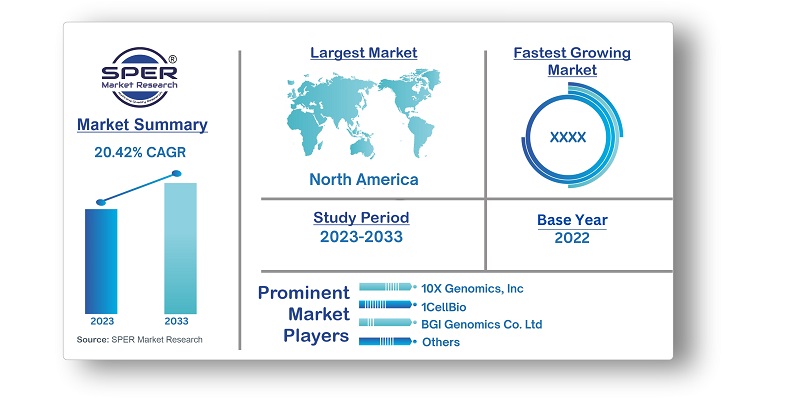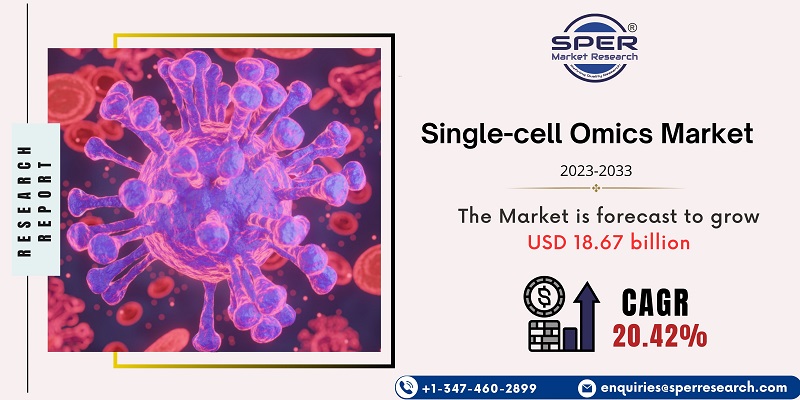
Single-cell Omics Market Growth, Size, Trends, Demand, Revenue, Challenges and Future Outlook
Single-cell Omics Market Size- Product, By Application, By End User- Regional Outlook, Competitive Strategies and Segment Forecast to 2033
| Published: Oct-2023 | Report ID: HLCA2364 | Pages: 1 - 234 | Formats*: |
| Category : Healthcare | |||
- BioExcel Diagnostic tools and Takara Bio USA, Inc., innovation life science reagent and device businesses, are developing and validating a current high and comprehensive technique for diagnosing infectious diseases based on syndromic markers. Takara Bio USA, Inc. is a wholly owned subsidiary of Takara Bio Inc.
- QIAGEN and Neuron23 Inc., an initial biotechnology company dedicated to developing precision medications for genetic neurological and immunological diseases, announced the signing of an agreement to create a partner screening for Neuron23's brain penetrant, blocker for Parkinson's disease.


| Report Metric | Details |
| Market size available for years | 2019-2033 |
| Base year considered | 2022 |
| Forecast period | 2023-2033 |
| Segments covered | Product, By Application, By End User |
| Regions covered | North America, Asia-Pacific, Latin America, Middle East & Africa and Europe |
| Companies Covered | 10X Genomics, Inc, 1CellBio, BGI Genomics Co. Ltd, Bio-Rad Laboratories, Inc, Celsee, Inc, Fluxion Biosciences, GE LifeSciences, Illumina, Inc, Mission Bio, and QIAGEN N.V. |
- Biotechnology and Pharmaceutical Companies
- Academic and Research Institutions
- Clinical Laboratories and Diagnostics Companies
- Biomedical Researchers
- Government and Regulatory Agencies
- Investors and Venture Capital Firms
- Healthcare Providers
- Genomic Service Providers
- Bioinformatics and Data Analysis Providers
| By Product: |
|
| By Application: |
|
| By End Use: |
|
- Global Single-cell Omics Market Size (FY’2023-FY’2033)
- Overview of Global Single-cell Omics Market
- Segmentation of Global Single-cell Omics Market By Product (Single Cell Genomics, Single Cell Proteomics, Single Cell Transcriptomics, Single Cell Metabolomics)
- Segmentation of Global Single-cell Omics Market By Application (Oncology, Cell Biology, Neurology, Immunology)
- Segmentation of Global Single-cell Omics Market By End User (Academic & Research Laboratories, Biotechnology & Pharmaceutical Companies, Hospitals & Diagnostic Laboratories, Others)
- Statistical Snap of Global Single-cell Omics Market
- Expansion Analysis of Global Single-cell Omics Market
- Problems and Obstacles in Global Single-cell Omics Market
- Competitive Landscape in the Global Single-cell Omics Market
- Impact of COVID-19 and Demonetization on Global Single-cell Omics Market
- Details on Current Investment in Global Single-cell Omics Market
- Competitive Analysis of Global Single-cell Omics Market
- Prominent Players in the Global Single-cell Omics Market
- SWOT Analysis of Global Single-cell Omics Market
- Global Single-cell Omics Market Future Outlook and Projections (FY’2023-FY’2033)
- Recommendations from Analyst
1.1. Scope of the report1.2. Market segment analysis
2.1. Research data source2.1.1. Secondary Data2.1.2. Primary Data2.1.3. SPER’s internal database2.1.4. Premium insight from KOL’s2.2. Market size estimation2.2.1. Top-down and Bottom-up approach2.3. Data triangulation
4.1. Driver, Restraint, Opportunity and Challenges analysis4.1.1. Drivers4.1.2. Restraints4.1.3. Opportunities4.1.4. Challenges4.2. COVID-19 Impacts of the Global Single-cell Omics Market
5.1. SWOT Analysis5.1.1. Strengths5.1.2. Weaknesses5.1.3. Opportunities5.1.4. Threats5.2. PESTEL Analysis5.2.1. Political Landscape5.2.2. Economic Landscape5.2.3. Social Landscape5.2.4. Technological Landscape5.2.5. Environmental Landscape5.2.6. Legal Landscape5.3. PORTER’s Five Forces5.3.1. Bargaining power of suppliers5.3.2. Bargaining power of buyers5.3.3. Threat of Substitute5.3.4. Threat of new entrant5.3.5. Competitive rivalry5.4. Heat Map Analysis
6.1. Global Single-cell Omics Market Manufacturing Base Distribution, Sales Area, Product Type6.2. Mergers & Acquisitions, Partnerships, Product Launch, and Collaboration in Global Single-cell Omics Market
7.1. Global Single-cell Omics Market Value Share and Forecast, By Product, 2023-20337.2. Single Cell Genomics7.3. Single Cell Proteomics7.4. Single Cell Transcriptomics7.5. Single Cell Metabolomics
8.1. Global Single-cell Omics Market Value Share and Forecast, By Application, 2023-20338.2. Oncology8.3. Cell Biology8.4. Neurology8.5. Immunology8.6. Others
9.1. Global Single-cell Omics Market Value Share and Forecast, By End Use, 2023-20339.2. Academic & Research Laboratories9.3. Biotechnology & Pharmaceutical Companies9.4. Hospitals & Diagnostic Laboratories9.5. Others
10.1. Global Single-cell Omics Market Size and Market Share
11.1. Global Single-cell Omics Market Size and Market Share By Product (2019-2026)11.2. Global Single-cell Omics Market Size and Market Share By Product (2027-2033)
12.1. Global Single-cell Omics Market Size and Market Share By Application (2019-2026)12.2. Global Single-cell Omics Market Size and Market Share By Application (2027-2033)
13.1. Global Single-cell Omics Market Size and Market Share By End User (2019-2026)13.2. Global Single-cell Omics Market Size and Market Share By End User (2027-2033)
14.1. Global Single-cell Omics Market Size and Market Share By Region (2019-2026)14.2. Global Single-cell Omics Market Size and Market Share By Region (2027-2033)14.3. Asia-Pacific14.3.1. Australia14.3.2. China14.3.3. India14.3.4. Japan14.3.5. South Korea14.3.6. Rest of Asia-Pacific14.4. Europe14.4.1. France14.4.2. Germany14.4.3. Italy14.4.4. Spain14.4.5. United Kingdom14.4.6. Rest of Europe14.5. Middle East and Africa14.5.1. Kingdom of Saudi Arabia14.5.2. United Arab Emirates14.5.3. Rest of Middle East & Africa14.6. North America14.6.1. Canada14.6.2. Mexico14.6.3. United States14.7. Latin America14.7.1. Argentina14.7.2. Brazil14.7.3. Rest of Latin America
15.1. 10X Genomics, Inc15.1.1. Company details15.1.2. Financial outlook15.1.3. Product summary15.1.4. Recent developments15.2. 1CellBio15.2.1. Company details15.2.2. Financial outlook15.2.3. Product summary15.2.4. Recent developments15.3. BGI Genomics Co. Ltd15.3.1. Company details15.3.2. Financial outlook15.3.3. Product summary15.3.4. Recent developments15.4. Bio-Rad Laboratories, Inc15.4.1. Company details15.4.2. Financial outlook15.4.3. Product summary15.4.4. Recent developments15.5. Celsee, Inc15.5.1. Company details15.5.2. Financial outlook15.5.3. Product summary15.5.4. Recent developments15.6. Fluxion Biosciences15.6.1. Company details15.6.2. Financial outlook15.6.3. Product summary15.6.4. Recent developments15.7. GE LifeSciences15.7.1. Company details15.7.2. Financial outlook15.7.3. Product summary15.7.4. Recent developments15.8. Illumina, Inc15.8.1. Company details15.8.2. Financial outlook15.8.3. Product summary15.8.4. Recent developments15.9. Mission Bio15.9.1. Company details15.9.2. Financial outlook15.9.3. Product summary15.9.4. Recent developments15.10. QIAGEN N.V15.10.1. Company details15.10.2. Financial outlook15.10.3. Product summary15.10.4. Recent developments15.11. Takara Bio15.11.1. Company details15.11.2. Financial outlook15.11.3. Product summary15.11.4. Recent developments15.12. Others
SPER Market Research’s methodology uses great emphasis on primary research to ensure that the market intelligence insights are up to date, reliable and accurate. Primary interviews are done with players involved in each phase of a supply chain to analyze the market forecasting. The secondary research method is used to help you fully understand how the future markets and the spending patterns look likes.
The report is based on in-depth qualitative and quantitative analysis of the Product Market. The quantitative analysis involves the application of various projection and sampling techniques. The qualitative analysis involves primary interviews, surveys, and vendor briefings. The data gathered as a result of these processes are validated through experts opinion. Our research methodology entails an ideal mixture of primary and secondary initiatives.



Frequently Asked Questions About This Report
PLACE AN ORDER
Year End Discount
Sample Report
Pre-Purchase Inquiry
NEED CUSTOMIZATION?
Request CustomizationCALL OR EMAIL US
100% Secure Payment






Related Reports
Our Global Clients
Our data-driven insights have influenced the strategy of 200+ reputed companies across the globe.




















